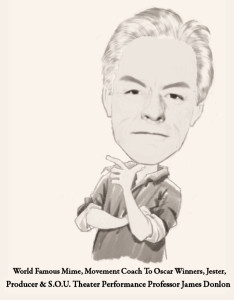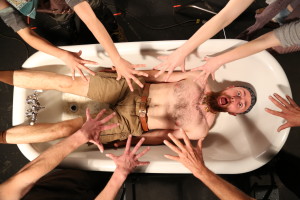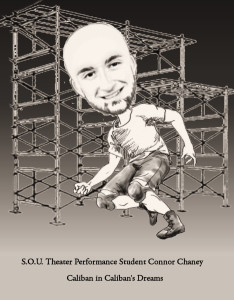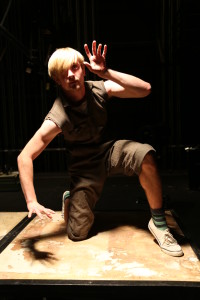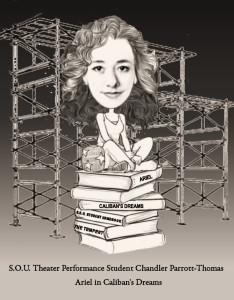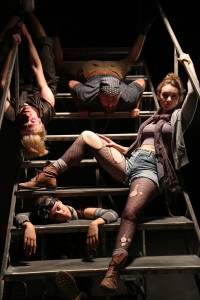Center Stage Theater’s Caliban’s Dreams
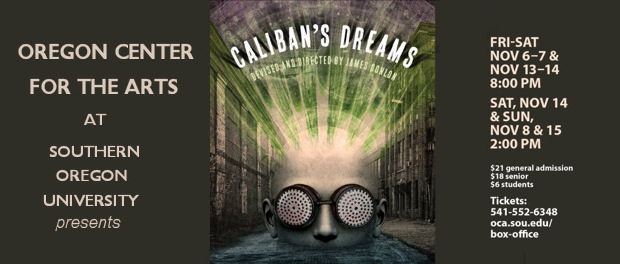 Caliban's Dreams
Caliban's Dreams
Caliban’s Dreams: Best Display Of Stage Movements You’ll Ever See
– by Lee Greene
On Saturday, Nov. 7, 2015, I had the great pleasure of attending a performance of the original new play by James Donlon, Caliban’s Dreams, staged and performed by students of the Southern Oregon University (S.O.U.) Theater Department at the Center Stage Theater on the university campus. It was an evening well spent, seeing a very clever, interesting and unusual play, well acted by the student thespians, but a play which is perhaps not every theater-goers cup of tea. So obviously, I need to elaborate.
First, as is my habit, some background. Let’s begin with the playwright. Mr. Donlon is an Associate Professor of Performance in the Theater Department at S.O.U. But while that does tell you something, it’s roughly the equivalent of saying the equally true statement that Al Gore is a professor at Middle Tennessee State University. It conveys a bit of useful information, but really doesn’t give you an accurate and complete description of the person and their place in the world. Just for starters, James Donlon is arguably the foremost mime active in the world today. (I won’t argue with anyone who wants to assert that THE foremost mime was the late Marcel Marceau, but Marceau passed away in 2007.) For those who remember the great American mime Robert Shields, who began his career working in the streets at San Francisco’s Union Square (where I, as a Cal Berkeley student, first saw him) and ultimately had his own hit television show (Shields and Yarnell Show), Donlon performed with Shields. “[H]e is the only physical theatre artist ever invited to perform with legendary San Francisco street mime Robert Shields of CBS’ Shields & Yarnell Show.” [James Donlon: A Conversation with Space and Time, https://www.sou.edu/theatre/donlon-qa.html] Shields though is no longer performing and instead is painting, sculpting and designing jewelry in Verde Valley, AZ. [Wikipedia, Shields and Yarnell, https://en.wikipedia.org/wiki/Shields_and_Yarnell#Robert_Shields] Switzerland’s L’impartial writes, “James Donlon is not only a genius of mime, he is also a complete artist, acrobat, juggler, unicyclist, and clown. A true apotheosis of a one-man show.” [James Donlon: A Conversation with Space and Time, https://www.sou.edu/theatre/donlon-qa.html] “Since 1970, Donlon’s career as a mime, clown, actor, and teacher has catapulted him around the world and across the United States. . . .” [Id.]
If you think you’ve now got a handle on Mr. Donlon, I’ve got news for you: that is just the tip of the iceberg. He has created or co-created a number of plays and one-man shows, served on the faculties of a variety of institutions training actors (like American Conservatory Theater, Yale School of Drama, and more than a half dozen others), founded several acting schools of his own, and taught future clowns at the Ringling Bros. and Barnum & Bailey Clown College, including Barry Lubin, Mark Stolzenburg, and Tony Award–winner Bill Irwin. [Id.] That would be an overfull resume for most people, but the extent of Donlon’s career doesn’t end there. He also has been a film movement coach for Oscar winners Javier Bardem, Kathy Bates, and Frances McDormand as well as Benjamin Bratt, David Strathairn, Giovanna Mezzojourno, and Catalina Sandino Moreno. He was a movement coach for PBS Great Performances and served on the sets of Dolores Claiborne and Love in the Time of Cholera. In short, he is one of those amazing, unique, little treasures residing in Southern Oregon, which make the cultural life here so rich and an education in the fine arts at the university here so valuable and worthwhile. With his talents, skills and background, the man could probably be any place in the world he wishes, but to our good fortune, he has chosen to sink roots in the Rogue Valley.
Now some background pertaining to the play, Caliban’s Dreams. Who IS this Caliban, doing all the dreaming? Well, as those who are well versed in their Shakespeare will immediately recognize, Caliban was a principal character in Shakespeare’s comedy, The Tempest. “Caliban is a Cambion, the half-human son of Sycorax by (according to Prospero, though this is not confirmed) a devil.” [Wikipedia, Caliban, https://en.wikipedia.org/wiki/Caliban] “In some traditions he is depicted as: a wild man, or a deformed man, or a beast man, or sometimes a mix of fish and man.” [Id.] In today’s vernacular, we might say that in Shakespeare’s play, Calban “had a thing for” Prospero’s daughter Miranda; he attempted to rape her, for the purpose of procreating and peopling his island, for which Prospero punished him by treating him harshly and cruelly through most of the play. Shakespeare gives Caliban some notable speeches in the play, the most well known being:
Be not afeard; the isle is full of noises,
Sounds, and sweet airs, that give delight and hurt not.(not hurt)
Sometimes a thousand twangling instruments
Will hum about mine ears; and sometime voices
That, if I then had waked after long sleep,
Will make me sleep again; and then in dreaming,
The clouds methought would open, and show riches
Ready to drop upon me, that when I waked
I cried to dream again.
[The Tempest, Act 2, Scene 3]
Thus, you now have a handle on Caliban AND his dreams. So, as my own high school English teacher, the late Charles Boyce, might say, “about the play, let’s get on with it already.” As I’ve previously noted, Caliban’s Dreams is an original new play, clever and interesting. As the title suggests, Mr. Donlon builds this play around Caliban and his dreams. But Caliban’s Dreams is not a traditional theater piece, not a drama told in chronological order like William Inge’s Bus Stop recently performed on the Craterian Theater stage or even in a series of flashbacks like Camelot Theatre’s recent production, The Last Five Years. Caliban’s Dreams is also not a rousing musical, like the past season’s Guys and Dolls at the Oregon Shakespeare Festival, though it does include a considerable variety of music, including recorded pop songs like The Doors’ Roadhouse Blues played over the theater’s sound system, and live music performed by the cast on stage on violin, flute, drums and other percussion devices, piano, etc.. Nor is it a typical comedy, like Oregon Cabaret Theatre’s The 39 Steps. I would describe it as a contemporary form of “Avante-garde” or Experimental theatre, discarding the typical conventions and forms of traditional proscenium theater. Although the Center Stage Theater is constructed as a traditional stage, writer/director Donlon has it set up for this production like an intimate thrust stage, with the audience seated not in the theater’s normal seats, but on risers actually sitting on two sides of the stage itself. So the actors are able to be, and often are, in more intimate contact with the audience than in a traditional theater setting. But Mr. Donlon goes even farther with this “Avante-garde” approach. Although not formally announced as such, the performance begins out in the lobby before the theater doors open. A substantial portion of the cast are present there, engaged in a variety of attention attracting activities, though nothing and no one identifies them as cast members rather than part of the waiting audience. A nice little pre-scene is also performed in the lobby, again never announced as such, and which could be taken at face value, interpreted as part of the normal, slightly aberrant life at a university. I’m not willing to give much more away in the form of spoilers, so I would just suggest if you go to see this play, arrive early and pay careful attention in the lobby while waiting for the theater doors to open.
Mr. Donlon has placed Caliban in a variety of times, locales, and contexts, which shift from scene to scene, always dreaming. But the dreams, of course, are very different depending upon the Caliban we’re observing. When the play begins on stage, we see a Caliban and retinue, in a post-modern decaying urban metropolis, in equally post-modern frayed attire, acting out the roles from a thick Shakespeare collection which begins in an honored place in center stage and makes its way well around the stage during the show. Over the course of the show, we see a Caliban who served in the Vietnam War – you can well imagine his nightmares, Caliban faced with life threatening health problems, a rural Caliban out on the farm, and a host of other embodiments of Calibans, all dreaming of course, and all the dreams fitting quite well with the description from Act 2, Scene 3 of The Tempest, but all very different. Mr. Donlon has the characters regularly quoting the text from Shakespeare’s The Tempest throughout the performance, particularly Caliban’s speeches. It is amusing, thought-provoking and certainly interesting hearing the Shakespearean lines recited in wildly differing contexts by very different incarnations of The Tempest’s characters in different scenes.
The absolute best thing about this play is the movement on and around the stage, which should be no surprise in a play from, and directed by, the master of stage movement, movement coach to Oscar winners, and king of the mimes, James Donlan. The play is an hour and a half of a constant, never-ending stream of eye-catching, entertaining stage movement. There’s no dozing off, no opportunity for the mind to wander to other things, because the performances in front of you on stage are mesmerizing, lively, energetic and non-stop. Having recently seen other plays which lagged between scenes, to the point of impatient frustration [for instance, see recent reviews of The Manchurian Candidate, http://performingarts.reviews/2015/10/24/camelot-theatres-the-manchurian-candidate/ and Bus Stop, http://performingarts.reviews/2015/09/18/next-stage-repertory-companys-bus-stop/], the movement, pacing and scene progression in this show were a revelation and a welcome change. I don’t know whether to applaud Mr. Donlon more for his prowess in constructing the play this way, or for his unqualified success in getting the student thespians to actually perform it that way.
There are 15 actors who take part in the play, fourteen of them Southern Oregon University (S.O.U.) Theater Department students. At least four play Caliban roles, though there is one who carries more of the Caliban burden than anyone else, Connor Chaney. I can’t say enough about how terrific Mr. Chaney’s performance was. My notes (frequent readers know, as do the unfortunate theater ushers who have to put up with me, that I take copious notes during a show) contain frequent, multiple, exuberant kudos for Mr. Chaney’s effective emoting and movement in the Caliban character, for his very accomplished recitation of Shakespeare’s Caliban lines from The Tempest, and for seemingly inhabiting the role, in all its many facets in this production. Looking at a publicity photograph of Mr. Chaney, out of character and out of costume, I was just stunned, for on stage, in this production, he looked nothing like his off-stage self, a complete transformation.
I want to be careful here, because there was not a bad performance anywhere at any time during the performance of Caliban’s Dreams I attended, and I do not mean to intentionally overlook any of the fine student actors who gave this show life. Again, I have to credit Mr. Donlon for the actors’ success, their consistently superior performances; they could not all be so good, without having been taught so well. But I do want to throw around some accolades.
Second only to Mr. Chaney’s performance was the acting of Galen Molk, who plays a variety of roles (Kado, Caliban, Ariel, etc.) in the changing scenes, including some of his own great reading of Caliban’s lines, a lot of muscular and dazzling movement, and even some of what might properly be described as romantic scenes. Cameron Gray provided a memorable performance as Prospero, beginning with that opening scene, and was consistently fine in roles in various following scenes.
There were just as many notable performances by the student actresses as the male actors. In The Tempest, Shakespeare has a character, Ariel, an “airy spirit” trapped in a tree by Caliban’s mother Sycorax, then freed by Prospero, who subsequently does Prospero’s bidding. (As an airy spirit, Ariel is an easy stretch for gender bending; Shakespeare appears to have intended it to be a male role, but on the stage in Caliban’s Dreams wouldn’t be the first time an actress has taken on the role.)
Again, the role switched cast members in different scenes, but the bulk of the Ariel role was performed by student actress Chandler Parrott-Thomas. My notes applaud her fine acting at various points in the play, very convincing “romantic” scenes, and highly impressive acrobatic movement, worthy of Olympics gymnastics, in some scenes.
Petite actress Margaret Chambers‘ stage persona dwarfs her size- she almost stole some scenes with her engaging stage movement, believably delivered dramatic lines and lovely contribution to the on-stage music.
I especially liked actress Halli Gibson during her turn in the Miranda role, which also switched cast members in different scenes, with Savannah Padilla also in the part. But for me, Ms. Padilla was much more amusing and memorable in her role as a taxi driver, driving (“put-put-put”) around the stage, delivering Caliban to a contemporary Exotic Dance Club (a whorehouse by any other name?). I hope the other student actors will forgive me for not singling out their specific work, but believe me Jacob Phillips, Nolan Sanchez, Alice Glass, Truett Felt, Scott Padian, Grey Smith and Aleah Zimmer all delivered fine performances and I would encourage readers to go see the show and decide for yourselves which were the best performances rather than simply taking my word for it. As I have reiterated, the performances were ALL good, there was not a bad one over the entire course of the show, so it’s difficult for me to describe them all, without going even more into excess detail than I already have.
There is one more performance I have to mention- that 15th actor, the non-student. At one point, James Donlon himself takes the stage, and the master mime gives a brief, but beguiling mime performance. I don’t want to spoil the surprise, so no details about when, how, how he was costumed, etc. But it’s such a gift he’s given both the students and the audience, to see the greatest mime at work. That’s a memory for a lifetime. You should go see this play for the wonderful performances of the actors and actresses, and to see an exemplary display of glorious stage movement. But if nothing else, go to see a glimpse of the great mime at work.
A word of caution. The theater program says “Contains strong language and adult themes.” They mean what it says. My own notes say CAUTION – strong language, swear words. I don’t think the use of strong language was gratuitous; it fits in the context of the times, locations and contexts where it was used. But if you’re sensitive to or offended by strong language, this is not the show for you. And the adult themes- well I’ve given several actors kudos for depicting very believable, realistic “romantic” scenes. They do a great job; but that’s suitable for adults, and perhaps not for small children.
Additional performances of Caliban’s Dreams are scheduled for Friday and Saturday, November 13 and 14 at 8 pm. and Saturday and Sunday, Nov. 14 and 15 at 2 pm. at the Center Stage Theater on the S.O.U. campus at Mountain Av., Ashland. Tickets are available by calling 541-552-6348 or online at http://bit.ly/1KlTDOr.
